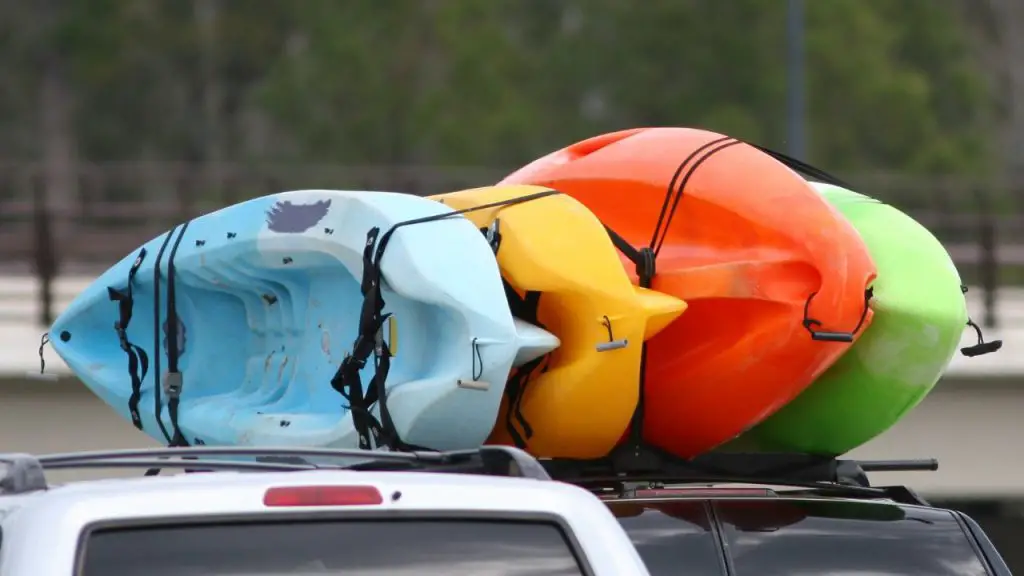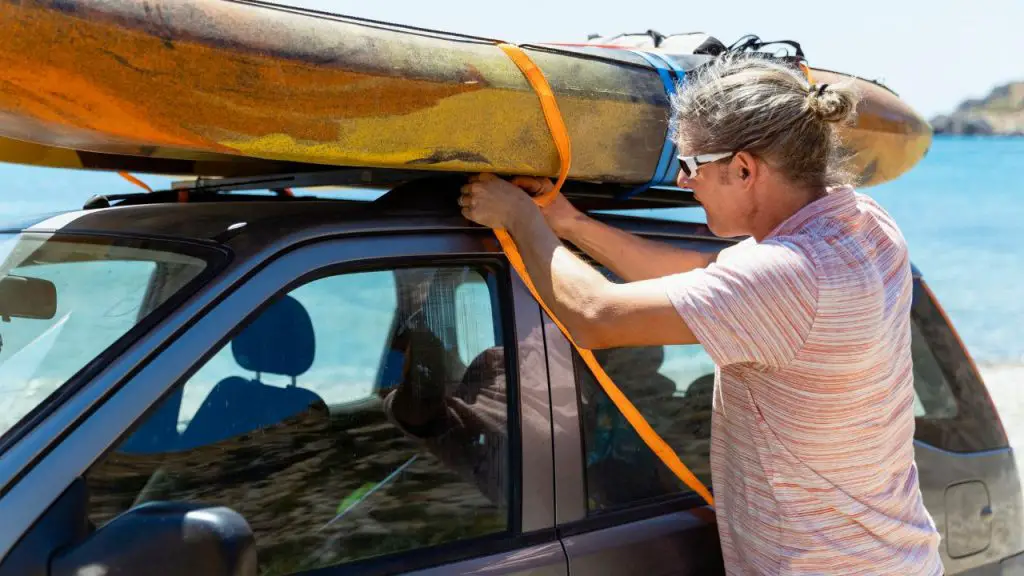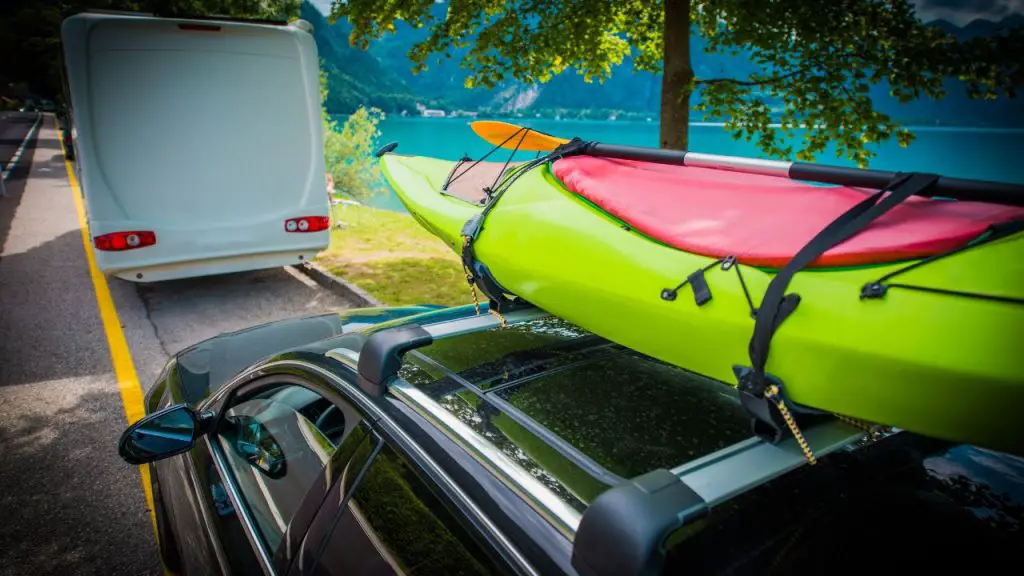Strapping a kayak on the roof rack is one of the most common methods of transporting a kayak, and that is so if you don’t drive a truck or have no kayak trailer. But how fast can you drive with a kayak on the roof of your car?
Transporting a kayak on your car’s roof can limit the speed at which to drive. That is because you don’t want to reach the destination with a damaged kayak, do you? Typically, the recommended maximum drive speed is about 65-75 MPH, but that depends on many factors.
Read on for detailed information on how fast to drive with a kayak on the roof. The post also includes how to tie down and transport a kayak.
Table of Contents
How Fast Should You Drive With a Kayak on Your Roof?
It is safe to drive at a speed of about 65-75 MPH with a kayak on the car’s roof as long as the kayak is correctly secured on your car’s top. However, your actual drive speed can be influenced by many factors include:
- The number of kayaks you are transporting.
- Speed limits on the road.
- Weather conditions.
The more kayaks you have on the roof, the slower you should drive.

Also, windy conditions will affect your driving speed. Maintain a speed of below 65 MPH when the wind is strong. Remember, the faster you drive, the higher the chances of something going wrong. You should always ensure the kayak is still stable on the roof. That is to say, it does not wobble or sway from side to side.
How fast to drive with a kayak on your roof also depends on the straps you use. The maximum speed you can get is 80 MPH when you use Yakima JayLow. You should, however, observe the speed limits on the road.
Pro tips:
Stop and check the kayak on the roof every 15 minutes. Pull over when it is safe and check that everything is still secure and that the kayak is not bobbing around. Check the straps to ensure nothing is loose.
Spend as much time as possible checking the kayak on the roof to ensure it is still securely strapped on the car’s roof and pointed straight ahead. It is the best way to safely transport your kayak.
How to Tie Down & Transport a Kayak
Most kayakers transport their kayaks on the roof of their cars, but you can also use other options. Consider the following alternatives:
- Kayak trailer
- Truck bed
If your car already has crossbars, you can tie your kayak to them for safe transportation. You can buy quality J-Cradles such as the Yakima’s JayLow and mount them on the roof rack to provide a stable platform for your kayak. Alternatively, you can use foam blocks or pool noodles.

Regardless of how you plan on transporting your kayaks, you still need to tie the kayak down perfectly and securely to avoid accidents on the road. Use the following steps to secure a kayak on the roof:
- Choose a suitable rope. A good quality rope will be made of sturdy material that will not stretch or break easily.
- Next, load the kayak onto the roof, ensuring it is balanced in the pool noodles, and strap the kayak. Generally, your kayak should be centered on the roof of your car and run parallel to it.
- Tie the boat to the roof rack. Tie one end of the rope to the front of the kayak and the other end to the rear of the roof rack. Ensure the rope is tight but not so tight that it bends or strains the rack.
- Run the straps through the cab. Take the cam straps and position the buckles on the side of the kayak and the inside of the crossbars.
- Secure the kayak’s cockpit. To do this, tie a second rope around the cockpit, ensuring it is tight enough to hold the kayak in place. However, it should not be so tight that it restricts movement.
- Test your knots. Before setting off, give your knots a good tug to ensure they are secure. Periodically check them during your journey in case they have come loose.
AUGO Ratchet Tie Down Straps
When You Should Slow Down
You should carefully drive when you have a kayak strapped on the roof of your car. That is because of the higher risks involved. Observe the traffic, driving conditions, and weather elements and slow down when you notice the following:
- Strong wind
- Sharp corners or turns
- Crowded traffic
- Approaching areas prone to collisions and accidents
Driving with a kayak on the car’s roof may force you to slow down or move at a speed lower than usual. As a result, your vehicle will consume more gas, requiring you to purchase more along the way. So, ensure your account has something when transporting a kayak on the roof of your car.

FAQs
How do you travel on a kayak with a roof?
Kayak’s shape makes it awkward to transport on the roof of a car. But you can make it safer if you invest in crossbars and J-Cradles. These accessories make strapping kayaks on the car’s roof much easier.
Is it better to transport a kayak upside down?
Yes. You are always recommended to transport your kayak upside down. The gunnels of the kayak are often the strongest sections of your kayak, and you need the kayak to rest on these points during transit to avoid creating dents on the hull.
How much wind is too much for kayaking?
Wind Speed above 10 knots or 11.5 MPH is generally too strong for kayaking. An offshore breeze with this speed will make it nearly impossible to paddle back to the shore.
Is 20 mph wind strong for kayaking?
Yes. The safe limit is about 11.5 MPH. So, an excess of 8.5 MPH can be disastrous, especially if you are not an experienced paddler. Constantly monitor the wind speed before every kayaking adventure.
In Conclusion
You can safely drive with a kayak on your roof at a speed of 65-75 MPH, but it depends on other factors. You may need to slow down when in a strong wind, negotiating bends, and approaching crowded traffic. Be keen on the road, and always check your kayak every 15 minutes to ensure everything is stable.
Thank you for your time at Windpaddle. We appreciate your time reading this article to the end and believe you found it helpful. Kindly share it with fellow paddlers to help enhance safety when transporting the kayak.


